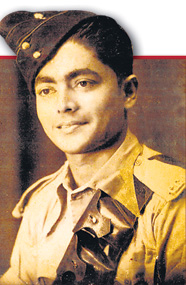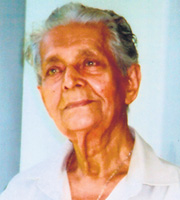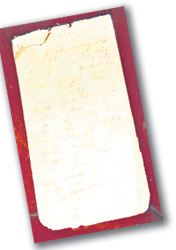
A burst of gunfire and all hell broke looseThe Cocos Mutiny, 66 years on, as recalled by (Donny) Vincent Ranasinghe, the last surviving member of the Ceylon Garrison Artillery (CGA) who served on the island At 84, (Donny) Vincent Ranasinghe is the last surviving member of the Ceylon Garrison Artillery (CGA) contingent that served on Cocos Islands during the Mutiny in 1942. On the night of May 8, 1942, Donny was caught in the crossfire of the rebellion, he recalled, when I met him recently at his home at Wattala. Vivid accounts of the uprising which the military had sought to keep secret were recorded by the writer Noel Crusz in ‘The Cocos Islands Mutiny'. Though all Donny's comrades on Cocos were absorbed in what was happening around them during those far-off days, he had jotted down at that time in a little notebook his thoughts on the dramatic events with the detachment of an observer. After a lapse of more than six decades, memories and impressions of those traumatic incidents remain, but the fears and anxiety have melted away.
Donny enlisted as a gunner in the CGA when he was 18 and was among a batch of soldiers who had volunteered to go to the Cocos-Keeling Islands to defend a strategically important communications facility there at the height of the Japanese naval advance. They sailed on the Kelantan from Colombo in early 1942. But a warning signal about hostile enemy activity on the high seas made the ship turn back to port. It was an inauspicious start for the 40 young soldiers on board. After several hours delay, the warship resumed its voyage to the idyllic Indian Ocean isles off Australia's northwest coast. The Cocos (Keeling) Islands, a score of atolls - lie stretched across the ocean between Australia and Sri Lanka. The Clunies-Ross family dynasty had ruled the isles since the 19th century and had brought in Malay workers to tend their coconut plantations. In 1978 Australia bought the islands from the fifth John Clunies- Ross for $ 6.25 million. The population of 665 Cocos Islanders opted in 1984 to integrate with Australia. During World War 2 CLI and CGA contingents - about 75 personnel - served on Direction and Horsburgh Islands to man and defend the vital cable and wireless station and surveillance base. Both islands are now uninhabited. On December 7, 1941, Japan struck Pearl Harbour and the US declared war. With the fall of Singapore, the largest British naval base in the Malay Straits in February, 1942 Winston Churchill, Britain's wartime premier acknowledged "it was the worst disaster and the largest capitulation in British history”. The debacle was followed by the Japanese occupation of Malaya, Burma, Andaman and Nicobar Islands and Christmas Island. Japanese planes also made an air strike on Direction atoll on Cocos. In February, in enemy action in the Bay of Bengal several Allied vessels had been sunk. The occupation of the Andaman Islands brought India and Ceylon and its strategic bases located in Calcutta, Madras and Colombo within range of Japanese bombers. In the enemy offensive the Indian Ocean islands were now targeted for capture. The Japanese juggernaut which was on a roll with the occupation of Korea and swathes of China was to culminate in the subjugation of the Far and South East Asia. Christmas Island was bombed in early March and captured eight days later. Thirty seven Indian soldiers stationed there had mutinied, killed their British commanding officer and surrendered to the Japanese: With war clouds looming over Ceylon, the British war cabinet appointed Admiral Geoffrey Layton as Commander-in-Chief. On Easter Sunday April 5, 1942, Japanese aircraft bombed Colombo and Trincomalee, the naval dockyard, the Air Force base and the oil depot there. The invasion of the island was imminent.
Meanwhile on another island outpost in the distant reaches of the Indian Ocean mounting fears of Japanese air strikes gripped the Ceylonese soldiers serving there and their morale was flagging by the day. George Gardiner, a British expatriate employed as an accountant in an export firm in Colombo, who had obtained an emergency war commission, was the commanding officer on Cocos. He ruled his men with a heavy hand. Bombardier Gratien Fernando, an ardent nationalist, who resented the brusque ways of his British superiors, was Captain Gardiner's formidable foil and was preparing to create trouble. With the Cocos increasingly vulnerable to Japanese attacks, Fernando began conspiring with a group of disgruntled CGA colleagues. He had a plan to make overtures to the Japanese on Christmas Island. He expected that Japan would help win Ceylon's independence and get rid of the British. Fernando who held the rank of guard commander was in charge of the sentry roster and had access to the ammunition stores. He had already won the sympathy of 30 out of 56 soldiers of his unit for his audacious plot. In the CGA contingent were soldiers who had been sent on to Cocos from Seychelles where they had faced discrimination from white officers. They nursed their old grudges against the colonial military establishment. They were to form the core of the mutiny's ringleaders. A crucial part of the plot related to the Rowe Battery with its two six-inch guns on Horsburgh Island; the observation post on a sixty-foot tower; and at its base a building with war shelter, duty officers' room, an artillery store and a guardroom where off-duty men slept. Near the big guns were ammunition pits and trenches. The battery entrance was to be guarded by a mutineer. Bombardier Fernando had carefully planned the uprising; a rehearsal had even been staged a week earlier. The first move was to disarm and lock in all off-duty guards. The conspirators would then remove the rifles from the guardroom. Fernando would then seize Gardiner and his deputy. On the night of May 8, gunner Donny Ranasinghe felt something amiss and tapped on the window of the guardroom to alert his comrades."I remember this incident vividly. Suddenly there was a burst of firing and a bullet grazed my left eyebrow. Blood was streaming down my face,” he recounted. His vision blurred, he was dazed. His colleague gunner Samaris Jayasekera came to his aid and rushed to fetch him a glass of water. Then a shot rang out. Samaris hit at close range by a bullet, fell dead. Fragments from the broken glass lay around his body. Donny was devastated. To this day he cherishes the memory of the kindly comrade and his parting gesture. Donny who had received medical treatment for his injuries from Dr. Menon Kumaran of the Ceylon Medical Corps, also testified at the court martial held on Horseburgh isle to try the mutineers. Donny Ranasinghe (aka R.A.V. Perera - his given name as a wartime soldier) is referred to several times in Crusz's book but there is no eyewitness account by him. To take the narrative forward, Lieutenant Stephens, Gardiner's deputy disturbed by the commotion ventured to find out what was happening; firing occurred again and he was hit on the leg. The camp now awoke to gunfire. It may have signalled the start of something ominous: a Japanese landing? But the mutineers knew that the game was up. When Fernando saw Gardiner advancing, he turned his gun on his commanding officer and pulled the trigger but the weapon failed to fire. The mutineers were now confronted with the rifles of soldiers and Gardiner's revolver pointing at them. Unnerved, Fernando moved towards the battery, picked up a white towel, fixed it to his rifle, and surrendered. The mutineers were immediately arrested.
The funeral of 23-year-old Jayasekera was held with full military honours on Horsburgh Island on the evening of May 10. A dozen troops selected to attend were present, as were some Malay inhabitants from a neighbouring island - friends of the dead soldier - who were allowed to attend. The simple boxwood coffin was lowered into the grave near a grove of palm trees. At the end of the 1950s, Jayasekera's remains were taken to Singapore for reburial in Singapore's Kranji War Memorial. Gardiner proceeded to conduct a court martial on Cocos in May 1942 - to try the 15 mutineers. The court martial verdict: 7 men who were found guilty were sentenced to death; and four soldiers received terms of imprisonment. As Noel Crusz notes, " ... but for the intervention of General Archibald Wavell, Commander-in-Chief, Allied Forces in the Far East" the seven convicted men "would have been executed at dawn". There was a complete blackout of news in Colombo about the mutiny because of wartime censorship. But word had reached the parents and relations of the convicted men, and they were frantic for information. They appealed to Sir Oliver Goonetilleke, then Civil Defence Commissioner and a member of the War Council to save the mutineers. Lieut. Ivor Van Twest of the CGA was entrusted with the task of bringing back on the Sutlej the ringleaders of the mutiny. It had been a turbulent passage from Cocos in the submarine-infested seas, and on arrival in Colombo the prisoners were marched under guard to the military jail in Flagstaff Street. Desperate for a reprieve the convicted men sought the assistance of Major Mervin Joseph, CGA, who helped draft their petitions. Two well-known political figures - H. W. Amarasuriya and Susantha de Fonseka, members of the pre-independence State Council, also made representations to the Governor Sir Andrew Caldecott and Admiral Geoffrey Layton, requesting clemency. However their pleas failed. On August 4, 1942 at 7.45 a.m. the prison van from the military detention barracks at Hulftsdorp took Gratien Fernando on his final journey to Welikade Prison's death row. He was hanged on August 5. On August 7, Benny de Silva was executed and on the following day Carlo Gauder, just seven days after his 21 birthday. "These were the only executions of British army soldiers for mutiny in the history of WW 2". As for the hanged men, "none of them has been commemorated by the Commonwealth War Graves Commission. This was not the case when British servicemen were executed,” according to Crusz. The words spoken by Gratien Fernando and his indomitable courage on the way to the gallows were on everybody's lips for weeks to come, both amongst prisoners and staff. “I have been to scores of executions but never did experience a disposition of such a nature,” said R.J.N. Jordan, a retired Deputy Commissioner of Prisons, recalling the execution of the leader of the mutiny. Donny and his mates after their tour of duty on Cocos returned home on the Somawathie just before Christmas 1942. The gunners were detailed for duty at the coastal artillery batteries at Galle Face, Battenberg, Mutwal and Colombo Harbour. Donny was posted to the Battenberg battery. But the stormy events on Cocos weighed heavily on the returnees; those memories still rankled. They also felt frustrated that promotions had been suspended. At the end of WW 2, the Cocos veterans were even denied the campaign medals for active war service. In 1943 Donny left the CGA on medical grounds and served a short stint as a book-keeper at the old Times of Ceylon newspaper company. He later served as an accountant in the plumbago/graphite mining companies: Bogala, Ruwanwella, Kahatagaha and Kolongaha, Dodangaslande. He now lives in retirement with his wife Anna, his daughter Thalindra and his son-in-law Lal. Donny and Anna also have three sons Ajantha, Ryle and Saliya who inherited Donny's athleticism and represented St. Benedict's College at cricket. After the war, several Cocos veterans migrated to Australia. In 2001 Crusz published his well-documented study of the Cocos mutiny. |
|
||||||
|| Front
Page | News | Editorial | Columns | Sports | Plus | Financial
Times | International | Mirror | TV
Times | Funday
Times || |
| |
Reproduction of articles permitted when used without any alterations to contents and a link to the source page.
|
© Copyright
2008 | Wijeya
Newspapers Ltd.Colombo. Sri Lanka. All Rights Reserved. |


